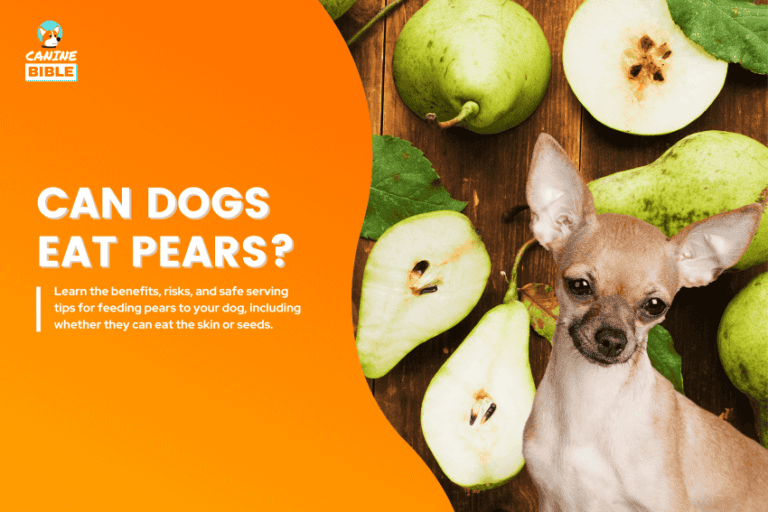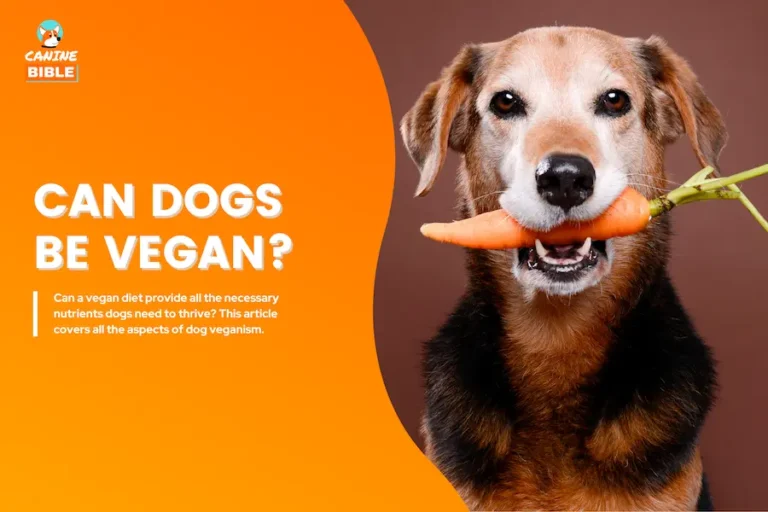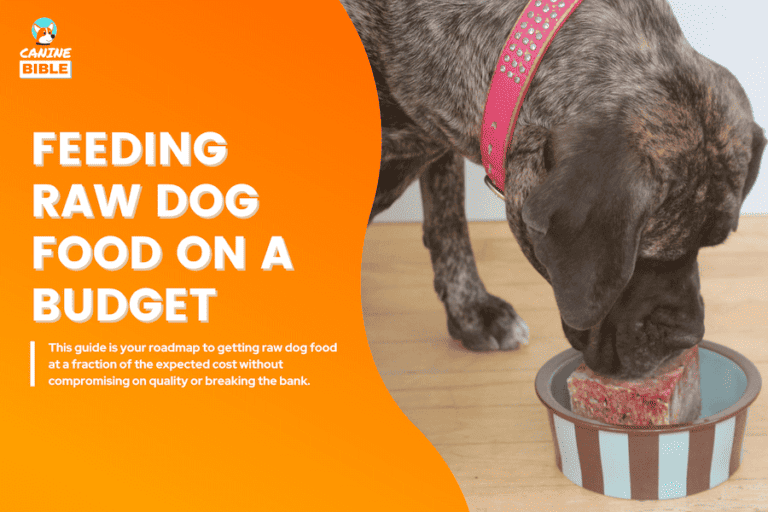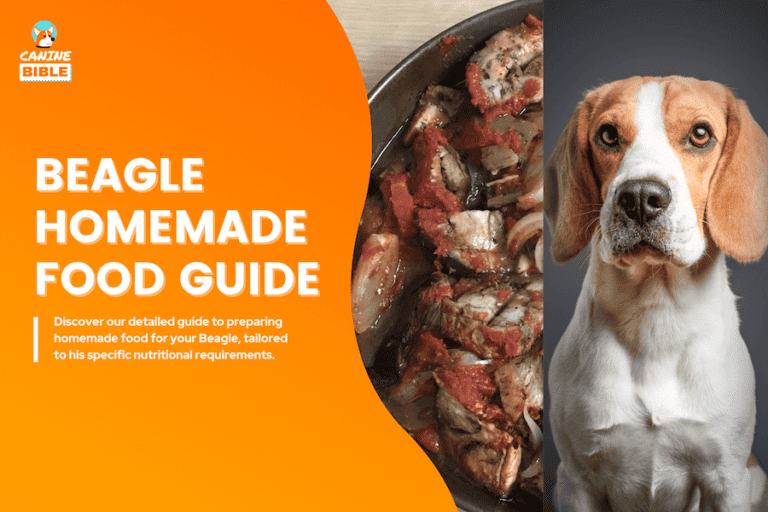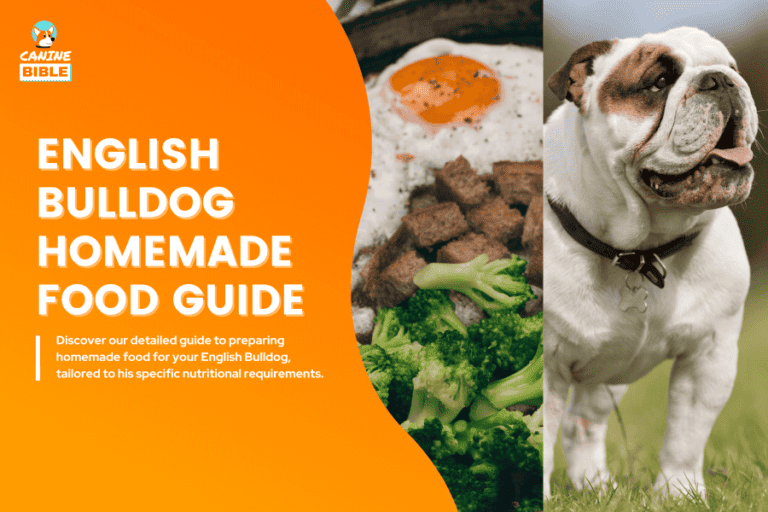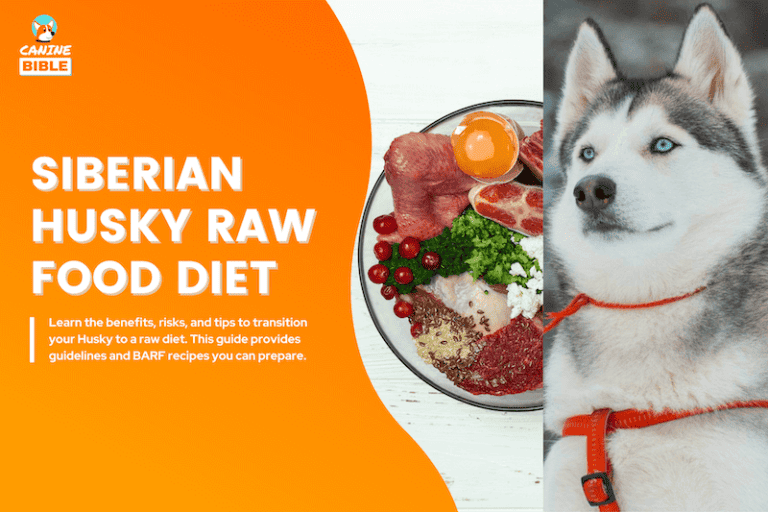Dog Feeding Chart: How Much Food to Feed My Dog?
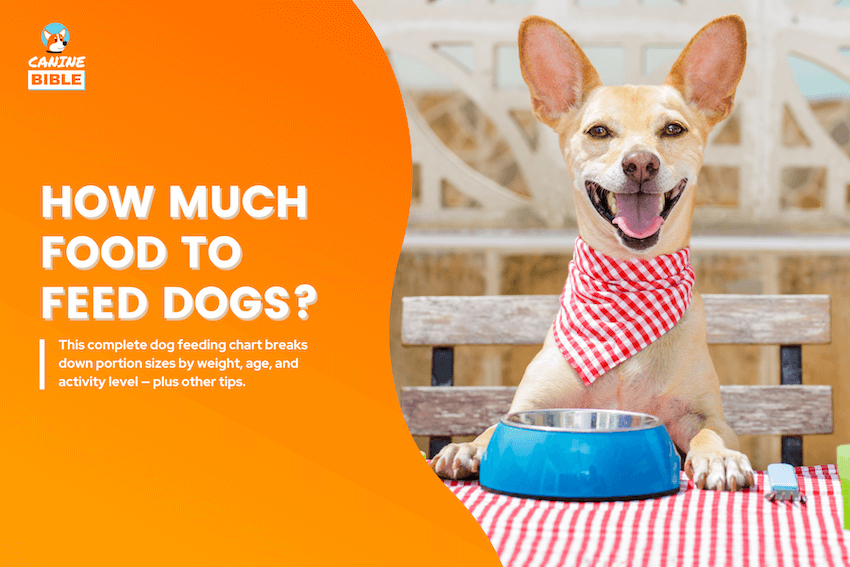
Canine Bible is reader-supported. We receive affiliate commissions via some of our links. Learn more.
Feeding your dog the right amount is one of the simplest yet most impactful ways to support their overall health, energy, and lifespan. But with countless food types, feeding trends, and conflicting advice, it’s easy to feel unsure about how much your dog really needs. That’s where a clear, weight- and age-based feeding chart can make all the difference. In this guide, we’ll walk you through how much to feed your dog at each life stage, how activity level affects portion size, and how to recognize signs of overfeeding or underfeeding. You’ll also get an easy-to-follow chart and practical tips to help you adjust portions confidently as your dog grows and changes.
Dog Feeding Chart by Weight
The easiest way to estimate how much food your dog needs is by using their current weight as a starting point. Below is a general daily feeding chart for adult dogs, assuming you’re feeding a standard commercial dry dog food (kibble). Keep in mind that different formulas have varying calorie densities, so always cross-check with the label on your food.
🐾 Note: These are general guidelines. Calorie needs can vary based on breed, activity level, and metabolism.
| Dog Weight | Daily Food Amount | Calories per Day |
|---|---|---|
| 5 lbs (2.3 kg) | ½ cup | ~200 – 275 kcal |
| 10 lbs (4.5 kg) | ¾ – 1 cup | ~300 – 450 kcal |
| 20 lbs (9 kg) | 1 ¼ – 1 ¾ cups | ~500 – 700 kcal |
| 30 lbs (13.6 kg) | 1 ¾ – 2 ¼ cups | ~750 – 900 kcal |
| 40 lbs (18 kg) | 2 ¼ – 2 ¾ cups | ~950 – 1100 kcal |
| 50 lbs (22.7 kg) | 2 ¾ – 3 ¼ cups | ~1100 – 1300 kcal |
| 60 lbs (27 kg) | 3 ¼ – 3 ¾ cups | ~1250 – 1450 kcal |
| 70 lbs (31.8 kg) | 3 ¾ – 4 ¼ cups | ~1400 – 1600 kcal |
| 80 lbs (36 kg) | 4 ¼ – 4 ¾ cups | ~1550 – 1750 kcal |
| 100+ lbs (45+ kg) | 5 – 6 cups+ | ~1800 – 2200 kcal+ |
Find the exact amount of calories your dog needs with our dog calorie calculator.
Dog Feeding Chart By Lifestage
Your dog’s nutritional needs change significantly as they grow from puppyhood to adulthood and into their senior years. Feeding the right amount — and the right type — of food at each stage is essential for their development, weight management, and overall health.
📌 Always check the label on your specific dog food bag for calorie content (kcal/cup) and adjust accordingly.
Puppy Feeding Chart (0–12 Months)
This chart gives you an estimate of how much food to feed your puppy per day based on their current weight and age. Puppies need more frequent meals and higher calories to support rapid growth.
| Puppy Weight | 6–12 Weeks | 3–4 Months | 5–7 Months | 8–12 Months |
|---|---|---|---|---|
| 5 lbs (2.3 kg) | 1 cup | ¾ cup | ¾ cup | ½ – ¾ cup |
| 10 lbs (4.5 kg) | 1½ cups | 1¼ cups | 1 cup | ¾ – 1 cup |
| 20 lbs (9 kg) | 2½ cups | 2 cups | 1½ – 1¾ cups | 1½ cups |
| 30 lbs (13.6 kg) | 3½ cups | 3 cups | 2½ – 2¾ cups | 2¼ – 2½ cups |
| 40 lbs (18 kg) | 4½ cups | 3¾ cups | 3¼ – 3½ cups | 2¾ – 3 cups |
| 50 lbs (22.7 kg) | 5¼ cups | 4½ cups | 3¾ – 4 cups | 3¼ – 3½ cups |
| 60 lbs (27 kg) | 6 cups | 5 cups | 4½ – 4¾ cups | 3¾ – 4 cups |
- 6–12 weeks: Feed 4 times per day
- 3–6 months: Feed 3 times per day
- 6–12 months: Feed 2 times per day
Notes:
- Large/giant breed puppies (e.g., Great Danes, Mastiffs) may require special large breed puppy formulas to slow growth and prevent orthopedic issues. Check our best puppy foods guide to find a suitable formula for your puppy.
- Avoid overfeeding — rapid growth can stress developing joints.
- Adjust amounts based on body condition and appetite. If ribs are visible, increase food slightly; if you can’t feel ribs easily, reduce the portion.
Adult Feeding Chart (1–6 Years)
Adult dogs have more stable energy requirements than puppies; however, their daily food intake still depends on factors such as weight, activity level, and metabolism.
| Dog Weight | Inactive / Senior | Moderately Active | Highly Active / Working Dog | Approx. Calories per Day |
|---|---|---|---|---|
| 5 lbs (2.3 kg) | ⅓ cup | ½ cup | ¾ cup | ~150–275 kcal |
| 10 lbs (4.5 kg) | ¾ cup | 1 cup | 1¼ cups | ~300–450 kcal |
| 20 lbs (9 kg) | 1 – 1¼ cups | 1½ – 1¾ cups | 2 cups | ~450–700 kcal |
| 30 lbs (13.6 kg) | 1½ – 1¾ cups | 2 – 2¼ cups | 2½ – 2¾ cups | ~650–900 kcal |
| 40 lbs (18 kg) | 1¾ – 2 cups | 2½ – 2¾ cups | 3 – 3¼ cups | ~800–1100 kcal |
| 50 lbs (22.7 kg) | 2 – 2¼ cups | 3 – 3¼ cups | 3½ – 3¾ cups | ~950–1300 kcal |
| 60 lbs (27 kg) | 2¼ – 2½ cups | 3½ – 3¾ cups | 4 – 4¼ cups | ~1100–1450 kcal |
| 70 lbs (32 kg) | 2½ – 2¾ cups | 4 – 4¼ cups | 4½ – 4¾ cups | ~1250–1600 kcal |
| 80 lbs (36 kg) | 2¾ – 3 cups | 4½ – 4¾ cups | 5 – 5½ cups | ~1400–1750 kcal |
| 100 lbs (45+ kg) | 3½ – 4 cups | 5½ – 6 cups | 6½ – 7 cups | ~1700–2200+ kcal |
- Divide the daily total into 2 meals/day.
- These are general guidelines; always monitor your dog’s body condition and adjust portions accordingly.
- Check our best dog food guide to find the best formula for your adult dog.
💡 Pro Tip: If your dog gains or loses weight unexpectedly, reassess feeding volume, check for hidden treat calories, and ensure they’re getting appropriate exercise.
Senior Feeding Chart (7+ Years)
As dogs age, their metabolism slows, activity levels decrease, and certain health issues (like joint pain or kidney problems) may affect their dietary needs. Feeding a senior-specific formula can help manage weight, protect joints, and support organ health.
| Dog Weight | Low Activity / Overweight | Moderately Active | Approx. Calories per Day |
|---|---|---|---|
| 5 lbs (2.3 kg) | ¼ – ⅓ cup | ½ cup | ~150–225 kcal |
| 10 lbs (4.5 kg) | ½ – ¾ cup | ¾ – 1 cup | ~250–350 kcal |
| 20 lbs (9 kg) | 1 – 1¼ cups | 1½ cups | ~400–550 kcal |
| 30 lbs (13.6 kg) | 1¼ – 1½ cups | 1¾ – 2 cups | ~600–750 kcal |
| 40 lbs (18 kg) | 1½ – 1¾ cups | 2¼ cups | ~700–900 kcal |
| 50 lbs (22.7 kg) | 1¾ – 2 cups | 2½ cups | ~850–1050 kcal |
| 60 lbs (27 kg) | 2 – 2¼ cups | 2¾ – 3 cups | ~1000–1200 kcal |
| 70 lbs (32 kg) | 2¼ – 2½ cups | 3¼ cups | ~1100–1300 kcal |
| 80 lbs (36 kg) | 2½ – 2¾ cups | 3½ cups | ~1200–1450 kcal |
| 100 lbs (45+ kg) | 3 – 3½ cups | 4 – 4½ cups | ~1400–1800+ kcal |
- Split into 2 meals per day
- Watch for signs of weight gain, lethargy, or muscle loss
- Add joint-support supplements (glucosamine, omega-3s) if not included in food
- Read our best senior dog foods guide to find a suitable formula for your puppy.
Special considerations for senior dogs:
- Prone to obesity – Keep portions in check
- Dental issues – Consider softer kibble or wet food
- Reduced activity – Needs fewer calories
- Increased risk of chronic illness – Consult your vet regularly
Feeding Chart for Pregnant Dogs
Pregnancy places unique nutritional demands on your dog. During this time, it’s crucial to increase food intake gradually, switch to a calorie-dense diet (like puppy food), and monitor her weight gain.
✅ Use high-quality puppy food during pregnancy and lactation — it’s higher in calories, protein, and essential nutrients.
| Pregnancy Stage | Weeks | Feeding Guidelines | Daily Increase |
|---|---|---|---|
| Early Pregnancy | 1–4 | Feed normal adult amount. No need to increase food yet. | No increase |
| Mid Pregnancy | 5–6 | Increase food slightly (5–10%). Start transitioning to puppy food. | +5–10% |
| Late Pregnancy | 7–9 | Increase food by 25–50%. Small, frequent meals. | +25–50% |
| Whelping / Nursing | After birth | Feed 2x to 3x her normal amount. High-fat, high-calorie diet. | Up to +200–300% |
Activity Level and Breed Size
Not all dogs burn energy at the same rate. A lazy couch-loving Bulldog and a high-energy Border Collie have vastly different caloric needs, even if they weigh the same. When determining how much to feed your dog, you must factor in their activity level, breed size, and weight.
Feeding Guidelines Based on Dog Activity Level
| Activity Level | Description | Feeding Adjustment |
|---|---|---|
| Low (Sedentary) | Mostly indoors, minimal daily exercise, often seniors or laid-back breeds | Feed ~75–90% of standard chart |
| Moderate (Normal) | Daily walks, some playtime, average household dog | Feed per standard chart |
| High (Active/Working) |
Active lifestyle, running, agility, herding, or working jobs (e.g., police, farm) | Feed 125–200% of standard chart |
Feeding Guidelines Based on Dog’s Size
Your dog’s breed size affects their metabolism, feeding frequency, and nutritional focus.
| Breed Size | Weight Range | Feeding Tips |
|---|---|---|
| Small Breeds | Under 20 lbs (9 kg) | Fast metabolism, often need more calories per pound. Feed smaller, more frequent meals. |
| Medium Breeds | 20–50 lbs (9–23 kg) | Average metabolism. Stick to feeding twice daily and monitor weight closely. |
| Large Breeds | 50–100 lbs (23–45 kg) | Slower metabolism. Risk of joint issues — don’t overfeed. Use large breed formulas. |
| Giant Breeds | Over 100 lbs (45+ kg) | Feed lower-calorie foods to avoid rapid growth and weight stress on joints. Split meals into 3 if bloating risk. |
Examples:
- A 70 lb Labrador Retriever who swims every day? Likely needs 20–30% more than the standard chart.
- A 15 lb French Bulldog who naps all day? May need 20% less than the average small-breed amount.
If your dog changes activity levels (e.g., recovering from surgery, starting agility training, switching seasons), update their portion size gradually over a few days to avoid digestive upset.
How Often Should You Feed Your Dog?
How often you feed your dog is just as important as how much. Meal timing impacts digestion, energy levels, and weight control. Feeding frequency should be based on your dog’s life stage, breed size, and individual needs.
| Life Stage | Frequency | Why | Feeding Tips |
|---|---|---|---|
| Puppies | 3–4 meals per day | Puppies have fast metabolisms and small stomachs. Frequent meals support growth and prevent blood sugar drops. | Stick to a regular schedule (e.g., 7 am / 12 pm / 5 pm) |
| Adult Dogs | 2 meals per day (morning & evening) | Two meals prevent hunger spikes, improve nutrient absorption, and lower bloat risk—especially in large breeds. | Feed 8–12 hours apart (e.g., 7 am and 6 pm) |
| Senior Dogs | 1–2 meals per day, depending on appetite and health | Seniors may have reduced activity and slower digestion. Some benefit from smaller, more frequent meals. | Adjust based on energy, medication schedule, and health conditions |
Feeding Frequency by Life Stage & Size
| Dog Type | Meals/Day | Notes |
|---|---|---|
| Small-Breed Puppy (under 6 mo) | 4 meals | Frequent meals help avoid hypoglycemia |
| Large-Breed Puppy | 3 meals | Slows down growth rate and supports bone development |
| Adult Dog (any size) | 2 meals | Most common and balanced feeding schedule |
| Large/Giant Adult | 2 meals | Splitting meals reduces bloat risk |
| Senior Dog (low appetite) | 1–2 meals | May need smaller, softer meals depending on dental or health issues |
| Pregnant/Nursing Dog | 3–4 meals | Higher demand — needs frequent small meals or free-feeding |
Should You Free-Feed?
Free-feeding (leaving food out all day) is not recommended for most adult dogs because it:
- Increases obesity risk
- Makes it hard to monitor appetite or detect illness
- Can cause behavioral issues around food
Only consider for pregnant/lactating dogs or underweight pups with vet guidance.
Other Considerations
- Keep a consistent meal schedule — dogs thrive on routine.
- Remove uneaten food after 15–20 minutes to prevent grazing.
- Use mealtimes as opportunities for mental stimulation and obedience training.
How to Measure Dog Food Accurately
Measuring your dog’s food properly is one of the simplest — yet most overlooked — ways to keep them healthy. Overfeeding is a leading cause of obesity in dogs, and it often happens because pet parents eyeball portions or use inconsistent scoops. Here’s how to do it right.
1. Use a standard measuring cup.
- Always use a dry measuring cup (the kind used for baking) — not a coffee mug, cereal bowl, or random scoop.
- One full 8-oz measuring cup = 1 cup of kibble.
- Level off the cup with a knife or your hand — don’t heap it.
- Don’t rely on “scoops” unless they show exact measurements.
2. For precision, weigh the food: Some foods are more calorie-dense than others. A cup of one brand’s kibble might weigh 80g, while another might weigh 110g.
- Use a digital kitchen scale for the most accurate results.
- Most feeding guides display amounts in grams per day or cups per day — convert as needed using your kibble’s label.
Example: If your dog needs 350 kcal/day and your food provides 400 kcal/cup → feed slightly under 1 cup/day.
3. For raw or wet food
- Raw and canned foods are often measured by weight, not volume.
- Feed based on percentage of body weight:
- Puppies: 5–10% of current body weight
- Adults: 2–3% of ideal body weight
Weigh raw or wet meals using a scale in grams or ounces. This ensures accuracy and prevents underfeeding or overfeeding. Use our raw dog feeding calculator to find the correct amount for your pet.
4. Include treats and extras
- Treats, chews, and table scraps add calories — often without you realizing it.
- General rule: Treats should make up no more than 10% of your dog’s daily calories.
- If giving extras, reduce meal portions slightly to compensate.
- Only feed the most nutritious and healthy dog treats.
Signs You’re Feeding the Right Amount
Knowing exactly how much to feed your dog is important, but even the best feeding charts are just a starting point. Every dog is different. That’s why observing your dog’s body condition, behavior, and energy levels is key to ensuring they’re getting the right amount of food.
| Category | Signs |
|---|---|
| Feeding the Right Amount |
• You can feel their ribs easily but can’t see them. • Visible waistline when viewed from above (hourglass shape). • Tummy tuck when viewed from the side. • Steady weight over time. |
| Overfeeding |
• Ribs are hard to feel under fat. • Round or oval shape, no defined waist. • Excessive weight gain over a short period. • Lethargy, low energy, or labored breathing during play. |
| Underfeeding |
• Prominent ribs, spine, or hip bones. • Visible loss of muscle mass. • Lethargy, weakness, or disinterest in food. • Dull coat and poor skin condition. |
🩺 Tip: If you’re unsure, ask your vet for a Body Condition Score (BCS) check — it’s like a dog version of BMI.
Poop Check: Your Dog’s Digestive Health
Believe it or not, your dog’s poop can tell you a lot about whether they’re getting the right amount (and type) of food.
| Poop Quality | What It Means |
|---|---|
| Firm, log-shaped | Normal digestion — feeding is just right |
| Soft or mushy | May be overeating or sensitive to diet |
| Hard, dry stools | Possibly underfed or dehydrated |
| Large volume, frequent | Overfeeding — body isn’t absorbing well |
Track weight monthly:
- For small dogs: use a home scale (weigh yourself with and without the dog).
- For large dogs: many pet stores or vet offices offer walk-on scales.
Adjust food up or down by 10% if you notice consistent weight changes or energy dips. You can also perform a dog gut health test to check if your dog’s poop and digestive system are healthy.
Behavior Clues
| Behavior | What It Might Mean |
|---|---|
| Constant begging | Could be boredom — not always hunger |
| Finishing meals & active | Good sign |
| Leaving food behind daily | Overfed or picky — reduce slightly |
When to Talk to a Vet
While feeding charts and guidelines are a great starting point, they aren’t one-size-fits-all. If you’re unsure about how much to feed your dog, or if something just seems “off,” your veterinarian should be your first stop.
Here are the key situations when a vet’s guidance is essential:
1. Sudden weight gain or loss: Noticeable weight changes without a change in food or exercise could indicate underlying health issues such as thyroid problems, diabetes, Cushing’s disease, or parasites. Your vet can run diagnostic tests and recommend dietary adjustments or medications.
2. Refusing to eat or always hungry: A loss of appetite lasting more than 24–48 hours may signal illness. On the other hand, extreme food obsession or constant begging, even with proper feeding, could point to malabsorption issues, worms, or metabolic problems.
3. Special health conditions: Dogs with certain conditions often require customized feeding plans:
- Pancreatitis – requires a low-fat diet
- Diabetes – needs consistent meal timing and portion control
- Kidney or liver disease – may need restricted protein or phosphorus
- Food allergies or intolerances – might need an elimination diet or prescription formula
Vets may recommend prescription or veterinary therapeutic diets in these situations.
4. Pregnancy, nursing, or recovery: Pregnant and nursing dogs have higher caloric needs and benefit from nutrient-dense food. Dogs recovering from surgery, illness, or injury might require adjusted portions, supplements, or appetite stimulants.
5. Switching dog foods: If you’re changing your dog’s food — for example, moving from adult to senior formula or transitioning to raw — your vet can help ensure a smooth process. They can also confirm the new food meets your dog’s nutritional requirements and help prevent digestive upset.
6. You’re confused about labels or nutrition: Dog food labels can be confusing. If you’re unsure whether your dog’s current food meets AAFCO nutritional standards, or if it suits their life stage and breed needs, a vet or veterinary nutritionist can provide expert advice.
The Bottom Line
Feeding your dog the right amount of food isn’t just about following a chart — it’s about understanding their unique needs, monitoring their body condition, and adjusting as they grow, age, or change activity levels. Whether you have a tiny teacup pup or a giant breed with a big appetite, getting their nutrition right sets the foundation for a longer, healthier life.
Use feeding charts as a helpful guide, but remember to observe your dog’s weight, behavior, and energy levels regularly. And when in doubt, your veterinarian is the best partner in helping tailor a diet plan that keeps your dog happy and thriving.
Sources
Canine Bible authorship represents the unified voice of our entire editorial team and our in-house veterinarians rather than a single author. Each article, blog post, and review published under the Canine Bible name undergoes a rigorous review process, involving all team members to guarantee accuracy and up-to-date in accordance with the latest veterinarian research. This collaborative effort is an integral part of our editorial process and aligns with our four pillars of content creation. This approach ensures our content is backed by expert knowledge and factual information, offering our readers reliable, actionable, and trustworthy content.


